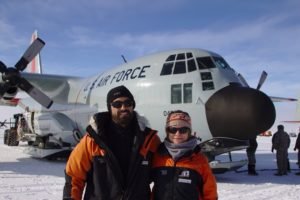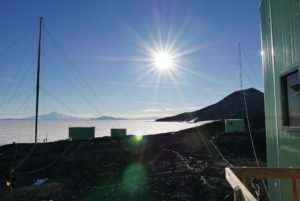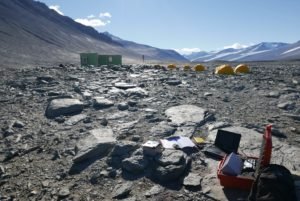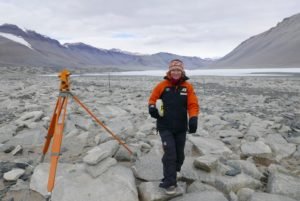A blog post by Tanja Petersen and Neville Palmer from their recent GNS Science trip to Antarctica to measure the Earth’s Magnetic Field.
It took 8 hours for the Hercules aircraft to fly from Christchurch to Williams airfield, a runway on the Ross ice shelf close to Scott Base. Both of us had never been to Antarctica before; we had a big smile on our faces when we stepped out from the airplane onto the ice being greeted by dry crisp cold air and what seemed like a never ending blanket of snow. Read up on the Hercules – it is a quite fascinating aircraft and has been around since the 50s!
The view from Crater Hill, a volcanic cinder cone on the foot hills of Mt Erebus, provides a fantastic overview of the settings of Scott Base. You can see Williams airfield (upper left corner); the boundary between the thick ice shelf and the thin sea ice meanders diagonally through the photo towards White Island in the distance. The pressure ridges on the sea ice are semi-circling the green painted buildings of Scott Base.
10pm at Scott Base. 24-hour sunlight! Looking out from the back towards the two geomag huts (left).
We are here to measure the strength and direction of the Earth’s magnetic field at two locations in the Ross Sea area, Lake Vanda & Cape Evans, where people have been repeatedly measuring it since 1974 and 1911, respectively. And we also want to check up on our equipment inside the two little green huts outside the back of Scott Base, which is continuously recording the local variations of the Earth’s magnetic field.
The accommodation for the night at Scott Base:
One of the many corridors inside Scott Base connecting the buildings of different sizes and shapes. Corner, stairs up, another corner, stairs down … a bit of a labyrinth for a newbie!
Häglund snow vehicle to the left, Mt Erebus in the background, a toilet tent, two sleeping tents, some shelters built into the snow and a flag marking a safe route.
The inside of Scott Base is being kept warm & cosy at T-shirt temperature, but outside it is more like -6 to -12 degrees C (including wind chill – important factor!). The Antarctic Field Training is giving us a good practice run on how to keep warm outside, before heading into the field. Antarctica New Zealand provided us with heaps of layers of warm clothes to wear.
We then were ready to load up the helicopter that flies us from Ross Island to Lake Vanda, in the Dry Valleys, 125 km away on the Antarctic mainland.
 The Wright Valley with Lake Vanda in the distance.
The Wright Valley with Lake Vanda in the distance.
Our fieldwork in the Dry Valleys, Antarctica, begins. First thing is to set up the fluxgate magnetometer near the Lake Vanda camp, before we walk to the nearby repeat measurement sites to get readings of the strength and directions of the magnetic field.
Neville is measuring the directions of the Earth’s magnetic field at Lake Vanda. In 1767 the South Magnetic Pole was located around here; now it is about 1720 km away. We are repeating these measurements several times over the course of four days.
Tanja on a special mission – the “P bottle” is part of keeping the environment as we found it.
After those four days working at Lake Vanda we continue to Cape Evans, Ross Island, Antarctica for a day. The historic magnetic hut there was constructed in 1911 as part of Scott’s Terra Nova expedition. It has asbestos in its wall panels; its structure is protected by a plywood construction around it. Inside that hut is the wooden pillar that Captain Robert Falcon Scott and his team of explorers used to take magnetic measurements before heading into their ill-fated expedition to the South Pole. Over 100 years later Neville performs the same type of measurements, but in a slightly different outfit.
The Terra Nova Hut nearby. Captain Scott’s base for his explorations of the frozen continent, in the early 1900s. It was also used by Shackletons’s Ross Sea party.
After completing our work successfully our flight back gets delayed and we have a bit of time for some recreational activities on the ice shelf close to Scott Base before heading home to New Zealand.
















Wow!,…so inspiration and amazing. you people are doing a wonderful job. I wish i could visit there. This is one of the places i want to visit in my short life.:) …Best wishes!
Those Who Come To Read Your Article Will Find Lots Of Helpful And Informative Tips
Things Are Very Open And Intensely Clear Explanation Of Issues. Was Truly Information. Your Website Is Very Beneficial.
Thank you for your post. This is excellent information. It is amazing and wonderful to visit your site.
I wanted to thank you for this great read!! I definitely enjoying every little bit of it I have you bookmarked to check out new stuff you post.
Drillly